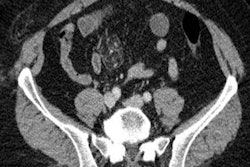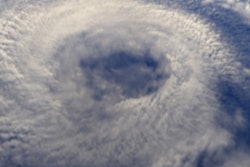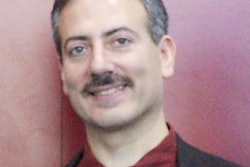
NEW YORK CITY - Hurricane Sandy was a catastrophic event for New York City, but it did have a silver lining for NYU Langone Medical Center's radiology department. With help from informatics, the storm precipitated significant and lasting workflow and quality improvements, according to a Thursday talk at the New York Medical Imaging Informatics Symposium (NYMIIS).
The awful hurricane was a crisis but also an opportunity, explained Dr. Michael Recht, chair of the hospital's radiology department.
"The only way we were [able to be] successful was really leveraging our belief and skill in informatics and the team that we have to create a momentum for change that was compelling and continues in our department today," he said.
Submerged MRI scanners
Despite taking many precautions in advance of Hurricane Sandy hitting the city on the evening of October 29, 2012, by the next morning, there was 14 ft of water in NYU Langone Medical Center's basement. The outpatient MR facility in the basement was under 15 million gallons of water, according to Recht.
 Dr. Michael Recht from NYU Langone Medical Center.
Dr. Michael Recht from NYU Langone Medical Center."We lost everything," he said. "Unfortunately, MR machines aren't built to deal with salt water very well."
Network connectivity to the main data center was lost, as Internet access had been provided through a telephone closet that was now underwater. It took two days to redo the infrastructure. Ultimately, the hospital was closed for approximately two months and had more than $2 billion in estimated costs from the damage.
The radiology equipment losses were obviously substantial, including five MR scanners (three outpatient and one inpatient, along with one 7-tesla animal system) and one dual-slice CT scanner, along with ancillary equipment such as injectors, coils, workstations, and supplies, Recht said. In addition, the department's access to all of its working space was lost.
"Even though some of our outpatient centers were still open -- we have centers across the five boroughs -- we had no place to read [those studies]," he said.
As a result, radiologists had to read at home, and the department had to determine how they would work together and communicate with referring offices, many of which were also closed.
The radiology department also had a teaching program with 40 residents and about 27 fellows, so the department had to figure out what to do them, as well as the faculty.
The hurricane also completely shut down research activities. In addition, the center's research MR systems were pressed into clinical service to make up for the losses of the four clinical MR scanners, Recht said.
Restoring radiology
Computer/PACS equipment that was salvageable was moved by faculty and staff; more than 60 faculty members, residents, medical students, staff radiologists, technologists, receptionists, and others answered the call to come in to the center and help with the project.
Ultrasound equipment was also moved, and a new space was created within a week in another building four blocks away.
"We were able to build an entirely new ultrasound reading area over a weekend," Recht said.
The first outpatient center reopened on October 31, two days after the hurricane struck. The main outpatient center took longer to recover, reopening on November 26.
"So we had to really push patients and technologists over to the other center," he said.
In addition to research scanners converted into clinical scanners, two mobile scanners were up and running within two weeks. A mobile outpatient scanner was actually driven into the building on a truck and adapted to be able to handle anesthesia patients.
The department next had to deal with the challenge of where to establish offices and reading rooms, Recht said, as there wasn't enough space at the new location to recreate the prior setup of 12 subspecialized reading rooms.
The institution created two temporary reading rooms. These communal environments eliminated silos and enhanced collaboration and collegiality, according to Recht.
Whereas radiology research and clinical departments had been separated by four city blocks before the hurricane, the new radiology department building now housed both research and clinical staff under one roof.
"We used the hurricane to bring us all together," he said.
New workflow
While the center had fewer MRI and CT scanners than before Sandy, it still had to accommodate the same number of patients. Furthermore, the department had to decide what to do with "extra" staff who would have been working on the other scanners but now had nothing to do.
Instead of furloughing or laying off staff, the department elected to pursue process improvement. Based on Lean Six Sigma principles, the improvement process involved all members of the team with promises that this wasn't just a cost-cutting initiative; all jobs were protected, although their functions might change, Recht said.
Based on these sessions, a series of changes were made, including rapid scheduling templates to accommodate extended night and weekend hours. The functions of technologists were changed and protocols were refined to match the duration of exam slots.
IT tools -- such as an electronic greaseboard/whiteboard -- were also furnished to give people the tools they needed to succeed, Recht said. Goals and benchmarks were defined for staff members, who were given access to the data.
"We significantly increased volume even though we were short on machines," he said.
Used by technologists on iPads, the electronic greaseboard app offers real-time views of the status of all the department's scanners and the patients scheduled to receive studies. Patients can be moved into slots, and technologists can exchange notes with each other. For CT, there's even a timer that counts down after a patient has received contrast.
One of the technologists who was nervous about using the app later told Recht that for the first time, she felt in control of her day.
Ultimately, the center may have lost imaging equipment, but it gained the use of more people per piece of equipment, Recht said. That and the process improvements led to a greater sense of teamwork and greater efficiency.
"Even after losing one-third of our outpatient CTs, our on-time performance in CT increased from 74% to 93%," he said. "Our numbers continue to increase. We're now doing 138 scans on two machines and our on-time performance is still greater than 90%."
Every one of the department's sections now has dashboards to provide data on turnaround, quality, and workflow. In addition, analytics has helped the department manage staffing for sites that have varying volumes.
Other quality initiatives
Radiologists have worked in interdisciplinary teams with referring physicians to develop institutional guidelines for following up findings such as ovarian masses, lung nodules, and pancreatic cysts, according to Recht.
Believing that radiologists need to add value for referring physicians and patients, the department also pursued initiatives such as reading rooms integrated into clinical floors, virtual radiology rounds, on-demand virtual consults, and multimedia reports.
The department has placed integrated reading rooms in clinical areas such as neurosurgery, urology, the cancer center, and the musculoskeletal center.
"It's really improved our visibility, not just to patients but also to referring physicians," he said.
Because radiologists can't be in all places at all times, the department used IT to implement virtual radiology rounds/consults with webcams to discuss cases. This initiative was piloted in the neonatal intensive care unit, pediatric cardiovascular care unit, neurology department, and musculoskeletal center. On-demand virtual consults with screen sharing are also being provided for external CDs.
The department is also moving toward the use of multimedia reports that include images, measurements, lesion tracking over time, graphs, references, and interactivity.
A new MR outpatient center is also being planned. A team of radiologists, technologists, front desk staff, IT personnel, nurses, administrators, and architects has already been formed to "try to make this a state-of-the-art and efficient center that we never had before," Recht said.
Educational benefits
None of the radiology residents or fellows had to move to other hospitals in the aftermath of Hurricane Sandy. Furthermore, they experienced benefits such as nontraditional shifts, increased didactic and interactive case conferences, increased resident-led teaching, class quality-improvement projects, and increased dedicated research time, he said.
Faculty also benefited in some ways from the hurricane, as the significantly decreased imaging volumes led to increased academic time. This led to more research papers and projects, as well as greater expertise.
On the downside, researchers suffered from the decreased availability of scanners and a drop in the amount of dedicated research time. However, their new proximity to clinical radiologists sparked more collaboration, including conferences and read-out sessions, Recht said.




















